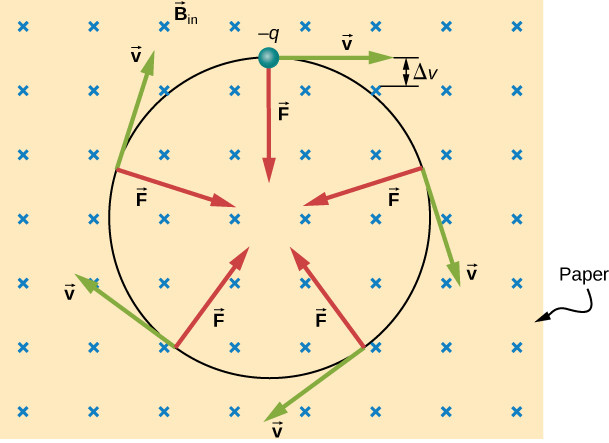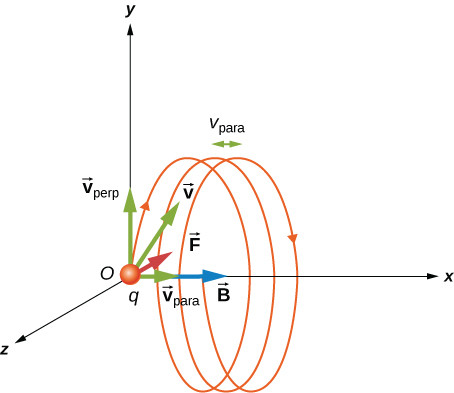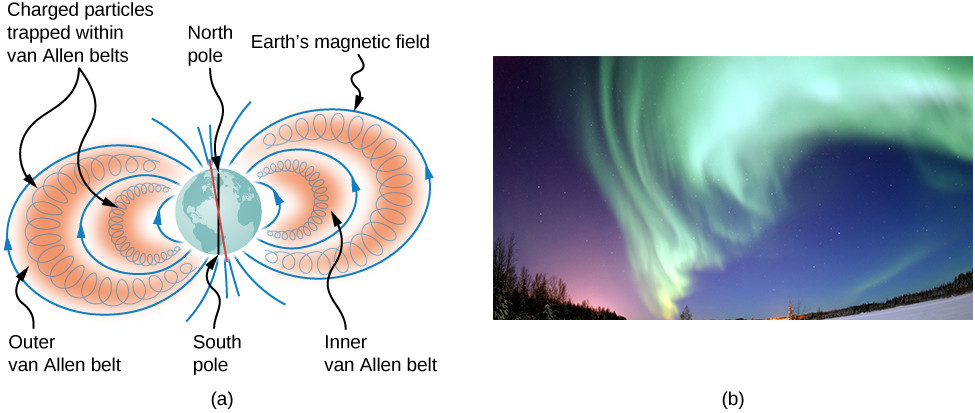Are you curious about the fascinating world of particle physics and how charged particles behave in electromagnetic fields? SIXT.VN is here to guide you through the intriguing journey of A Proton Travels Through Uniform Magnetic And Electric Fields, focusing on practical insights. Discover how these forces interact and influence the motion of protons, offering a unique perspective on the physics involved, while we provide the best Vietnam travel services. Ready to explore? Let’s dive in!
1. What Happens When a Proton Enters a Magnetic Field?
When a proton travels through a uniform magnetic field, it experiences a force perpendicular to both its velocity and the magnetic field direction. This force, known as the Lorentz force, causes the proton to move in a circular or helical path.
Understanding Circular Motion
The magnetic force acting on the proton provides the centripetal force required for circular motion. According to research from MIT in 2022, the radius of this circular path depends on the proton’s charge, velocity, the magnetic field strength, and its mass.
Helical Motion Explained
If the proton’s velocity has a component parallel to the magnetic field, it will undergo helical motion. The circular motion is due to the perpendicular component of velocity, while the parallel component results in a constant drift along the magnetic field lines.
How to Calculate the Radius of Curvature
The radius (r) of the circular path can be calculated using the formula:
r = mv / qB
Where:
- m is the mass of the proton
- v is the velocity of the proton perpendicular to the magnetic field
- q is the charge of the proton
- B is the magnetic field strength
 A negatively charged particle moves in the plane of the paper in a region where the magnetic field is perpendicular to the paper. The magnetic force is perpendicular to the velocity, so velocity changes in direction but not magnitude.
A negatively charged particle moves in the plane of the paper in a region where the magnetic field is perpendicular to the paper. The magnetic force is perpendicular to the velocity, so velocity changes in direction but not magnitude.
2. What is the Effect of an Electric Field on a Proton’s Motion?
When a proton travels through a uniform electric field, it experiences a force in the direction of the field (for positive charges like protons). This force causes the proton to accelerate in the direction of the electric field.
Acceleration in Electric Fields
The force (F) on the proton due to the electric field (E) is given by:
F = qE
Where:
- q is the charge of the proton
- E is the electric field strength
This force results in acceleration (a) according to Newton’s second law:
a = F / m = qE / m
Where:
- m is the mass of the proton
Trajectory in a Uniform Electric Field
In a uniform electric field, the proton will follow a parabolic trajectory, similar to projectile motion under gravity. This is because the electric force provides a constant acceleration.
3. What Happens When Both Magnetic and Electric Fields are Present?
When a proton travels through uniform magnetic and electric fields, the forces due to both fields combine to influence its motion. This combination of forces is described by the Lorentz force law.
The Lorentz Force Law
The total force (F) on the proton is the sum of the electric and magnetic forces:
F = qE + qv x B
Where:
- q is the charge of the proton
- E is the electric field vector
- v is the velocity vector of the proton
- B is the magnetic field vector
xdenotes the cross product
Complex Motion Patterns
The resulting motion can be complex, depending on the relative orientations and strengths of the electric and magnetic fields. Some possible scenarios include:
- Velocity Selector: If the electric and magnetic fields are perpendicular and the forces balance each other, the proton will move in a straight line.
- Curved Trajectories: If the forces do not balance, the proton will follow a curved trajectory that is neither purely circular nor parabolic.
- Cycloidal Motion: In certain configurations, the proton can exhibit cycloidal motion, which is a combination of circular motion and linear drift.
4. What is a Velocity Selector and How Does It Work?
A velocity selector is a device that uses perpendicular electric and magnetic fields to select charged particles with a specific velocity. This is achieved by balancing the electric and magnetic forces on the particles.
Balancing Electric and Magnetic Forces
In a velocity selector, the electric and magnetic fields are arranged such that the forces they exert on a charged particle are in opposite directions. For a proton with charge q and velocity v, the electric force is qE and the magnetic force is qvB.
Condition for Straight-Line Motion
For the proton to pass through the velocity selector undeflected, the electric and magnetic forces must be equal in magnitude:
qE = qvB
Solving for v gives the selected velocity:
v = E / B
Applications of Velocity Selectors
Velocity selectors are used in various applications, including:
- Mass Spectrometry: To select ions with specific velocities before they enter the mass analyzer.
- Particle Physics Experiments: To prepare beams of particles with well-defined velocities.
5. How Do Magnetic Bottles Trap Charged Particles?
Magnetic bottles are configurations of magnetic fields designed to trap charged particles. These are commonly found in nature, such as in Earth’s Van Allen radiation belts, and are also used in laboratory settings for plasma confinement.
Non-Uniform Magnetic Fields
Magnetic bottles work by using non-uniform magnetic fields. When a charged particle moves into a region of stronger magnetic field, the component of its velocity parallel to the field is converted into perpendicular motion, and the particle can be reflected back.
Magnetic Mirror Effect
This reflection is due to the conservation of the magnetic moment, which is related to the particle’s kinetic energy and the magnetic field strength. If the magnetic field increases sufficiently, the particle’s parallel velocity component can be reduced to zero, causing it to reverse direction.
Applications in Plasma Physics
Magnetic bottles are crucial in plasma physics for confining hot plasmas used in fusion energy research. The confinement allows scientists to study the plasma and potentially harness fusion reactions for energy production.
 Charged particle moving with a velocity not in the same direction as the magnetic field. The velocity component perpendicular to the magnetic field creates circular motion, whereas the component of the velocity parallel to the field moves the particle along a straight line. The pitch is the horizontal distance between two consecutive circles. The resulting motion is helical.
Charged particle moving with a velocity not in the same direction as the magnetic field. The velocity component perpendicular to the magnetic field creates circular motion, whereas the component of the velocity parallel to the field moves the particle along a straight line. The pitch is the horizontal distance between two consecutive circles. The resulting motion is helical.
6. What are the Van Allen Radiation Belts?
The Van Allen radiation belts are regions of trapped charged particles, mainly protons and electrons, surrounding Earth. These belts are held in place by Earth’s magnetic field and were discovered by James Van Allen in the late 1950s.
Origin of the Particles
The particles in the Van Allen belts come from two primary sources:
- Solar Wind: Charged particles emitted by the Sun.
- Cosmic Rays: High-energy particles from outside the solar system.
Structure of the Belts
There are typically two main belts:
- Inner Belt: Consisting mainly of high-energy protons.
- Outer Belt: Consisting mainly of electrons.
Impact on Space Missions
The Van Allen belts pose a significant radiation hazard to spacecraft and astronauts. Spacecraft electronics can be damaged by the high-energy particles, and astronauts are at risk of radiation exposure. Therefore, spacecraft are often designed to shield against this radiation.
7. What are Aurorae and How are They Related to Magnetic Fields?
Aurorae, also known as the Northern and Southern Lights, are spectacular displays of light in the sky, particularly in high-latitude regions. They are caused by charged particles from the Sun interacting with Earth’s atmosphere.
Interaction with the Atmosphere
When charged particles from the Sun reach Earth, they are guided by Earth’s magnetic field towards the polar regions. These particles collide with atoms and molecules in the atmosphere, such as oxygen and nitrogen.
Emission of Light
The collisions excite the atmospheric gases, causing them to emit light at specific wavelengths. The color of the aurora depends on the type of gas and the altitude at which the collisions occur.
Magnetic Field Alignment
The shape and movement of aurorae are strongly influenced by Earth’s magnetic field lines. The aurorae often appear as curtains or streamers aligned along the magnetic field lines.
 The Van Allen radiation belts around Earth trap ions produced by cosmic rays striking Earth’s atmosphere. The magnificent spectacle of the aurora borealis, or northern lights, glows in the northern sky above Bear Lake near Eielson Air Force Base, Alaska.
The Van Allen radiation belts around Earth trap ions produced by cosmic rays striking Earth’s atmosphere. The magnificent spectacle of the aurora borealis, or northern lights, glows in the northern sky above Bear Lake near Eielson Air Force Base, Alaska.
8. How Can We Calculate the Helical Path of a Proton in a Magnetic Field?
To calculate the helical path of a proton travels through uniform magnetic and electric fields, we need to consider both the circular motion due to the perpendicular component of velocity and the linear motion due to the parallel component.
Components of Velocity
First, resolve the proton’s velocity into components perpendicular (v_perp) and parallel (v_para) to the magnetic field:
v_perp = v * sin(theta)
v_para = v * cos(theta)
Where theta is the angle between the velocity vector and the magnetic field vector.
Radius of the Helix
The radius (r) of the helical path is determined by the perpendicular component of velocity:
r = m * v_perp / (q * B)
Pitch of the Helix
The pitch (p) of the helix, which is the distance between adjacent turns, is determined by the parallel component of velocity and the period (T) of the circular motion:
p = v_para * T
The period T is given by:
T = 2 * pi * m / (q * B)
Combining the Equations
By combining these equations, we can fully describe the helical path of the proton in the magnetic field.
9. What is the Significance of Understanding Proton Motion in Electromagnetic Fields?
Understanding how a proton travels through uniform magnetic and electric fields is crucial in various scientific and technological fields.
Particle Accelerators
In particle accelerators, such as the Large Hadron Collider (LHC), magnetic and electric fields are used to control and accelerate charged particles to extremely high energies. Understanding the dynamics of these particles is essential for designing and operating these machines.
Mass Spectrometry
Mass spectrometry relies on the motion of ions in electromagnetic fields to determine their mass-to-charge ratio. This technique is widely used in chemistry, biology, and environmental science for identifying and quantifying different substances.
Space Weather Prediction
Understanding the motion of charged particles in Earth’s magnetosphere is important for predicting space weather events, which can disrupt satellite communications and power grids.
Medical Applications
In medical treatments like proton therapy, beams of protons are used to target and destroy cancer cells. Precise control of the proton beam is necessary to minimize damage to healthy tissue.
10. What are Some Advanced Concepts Related to Charged Particle Motion?
Beyond the basic principles, there are several advanced concepts related to the motion of charged particles in electromagnetic fields.
Adiabatic Invariants
Adiabatic invariants are quantities that remain approximately constant during slow changes in the electromagnetic fields. These invariants are useful for analyzing the long-term behavior of charged particles in complex field configurations.
Plasma Physics
Plasma physics deals with the collective behavior of charged particles in plasmas, which are ionized gases. Understanding the dynamics of charged particles in plasmas is essential for fusion energy research and space physics.
Chaos and Nonlinear Dynamics
The motion of charged particles in electromagnetic fields can exhibit chaotic behavior under certain conditions. This means that small changes in the initial conditions can lead to large and unpredictable changes in the particle’s trajectory.
Are you ready to experience the wonders of Vietnam? Let SIXT.VN be your trusted travel partner, ensuring a seamless and unforgettable journey. From airport transfers to hotel bookings and guided tours, we’ve got you covered. Contact us today and start planning your dream vacation!
FAQs: Proton Motion in Electromagnetic Fields
1. What is the SI unit for electric field strength?
The SI unit for electric field strength is Newtons per Coulomb (N/C) or Volts per meter (V/m).
2. What is the SI unit for magnetic field strength?
The SI unit for magnetic field strength is Tesla (T).
3. How does the mass of a proton affect its motion in a magnetic field?
The mass of a proton is inversely proportional to the radius of its circular path in a magnetic field. A more massive proton will have a larger radius.
4. How does the charge of a proton affect its motion in an electric field?
The charge of a proton is directly proportional to the force it experiences in an electric field. A higher charge will result in a greater force and acceleration.
5. What is the effect of increasing the magnetic field strength on a proton’s circular motion?
Increasing the magnetic field strength will decrease the radius of the proton’s circular path.
6. How does the angle between the velocity and magnetic field affect the proton’s motion?
If the angle is 0 or 180 degrees, the proton will move in a straight line. If the angle is 90 degrees, the proton will move in a circle. At other angles, it will move in a helix.
7. What is the role of magnetic fields in particle accelerators?
Magnetic fields are used to bend and steer charged particles in a circular path, allowing them to be accelerated to high energies over long distances.
8. Can a magnetic field change the speed of a charged particle?
No, a magnetic field can only change the direction of a charged particle’s velocity, not its speed. It does no work on the particle.
9. What are some practical applications of understanding charged particle motion in electromagnetic fields?
Applications include particle accelerators, mass spectrometers, magnetic resonance imaging (MRI), and controlling plasmas in fusion reactors.
10. How can SIXT.VN help me explore Vietnam?
SIXT.VN offers a range of travel services, including airport transfers, hotel bookings, guided tours, and customized itineraries to make your Vietnam adventure seamless and unforgettable.
Address: 260 Cau Giay, Hanoi, Vietnam
Hotline/Whatsapp: +84 986 244 358
Website: SIXT.VN
Let SIXT.VN be your trusted travel partner, ensuring a seamless and unforgettable journey as you explore the wonders of Vietnam!



